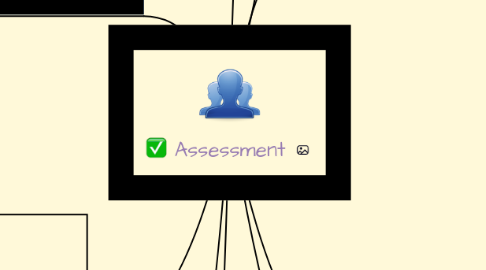
1. Performance
1.1. Individual
1.2. Group projects
1.3. Portfolios
1.4. Student logs
1.4.1. Graphing to show where students are excelling on different assessments
1.5. Journals
1.5.1. Write about different topics in math that they are good in and write about different topics they aren't good in.
2. Summative
2.1. Planning Summative Assessments
2.1.1. End of a large chunk of learning
2.1.2. Review what you want to do
2.1.3. Criteria for ensuring high-quality assessment
2.1.4. Representative sampling
2.1.5. Standardized testing, final exams, major cumulative projects, research projects
2.2. Preparing students
2.2.1. Teach assessment taking skills
2.2.2. Test length, format, types of questions
2.2.3. Review
2.2.4. Item type and format
2.2.5. Assessment anxiety
2.3. Conducting Summative Assessments
2.3.1. When they should be scheduled
2.3.2. When they should be created
2.3.3. Assessment directions
2.3.4. Arrange items
2.3.5. Physical layout
3. Reflective
3.1. Take ownership over their thinking
3.1.1. Look over their tests and write about why they chose their answers.
4. Standards Based
4.1. TEKS
4.1.1. STARR test
4.2. Standards
4.2.1. District Assessments
5. Helping students be successful one assessment at a time!
6. Formative
6.1. Definition:
6.1.1. Process of gathering evidence of student learning.
6.2. Characteristics
6.2.1. Evidence of student learning
6.2.2. Structure
6.2.3. Participants involved feedback
6.2.4. Instruction adjustments
6.3. Often and during the course of instruction
6.3.1. Thumbs- up, thumbs-down
6.3.2. Fist to 5
6.3.3. Traffic Light
6.4. 6 Different Types of Formal Formative
6.4.1. Structured exercises
6.4.2. Pretest
6.4.3. Homework
6.4.4. In-class assignments
6.4.5. Quizzes and unit tests
6.4.6. Classroom response systems
6.5. Formative Assessment Cycle
6.5.1. 1. Gather evidence
6.5.2. 2. Evaluate evidence
6.5.3. 3. Feedback
6.5.4. 4. Adjust instruction
7. Interim/Benchmark
7.1. Periodic testing throughout school year
7.1.1. Six weeks test
7.1.2. Chapter tests
7.2. Low-level
7.3. Little or no student feedback
7.3.1. Student feedback given only if conferences are made with each student.
7.4. More formal style using projects, written assignments and tests
8. Authentic
8.1. Not just a test, but what they do daily
8.1.1. Graded work that's done in class
9. Multiple Response Formats
9.1. Assessing in different ways
9.1.1. Running Records
